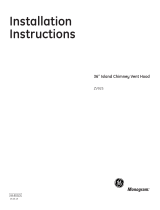Safety Information
2
BEFORE YOU BEGIN
Read these instructions completely and carefully.
•
IMPORTANT— Save these instructions for
local inspector’s use.
•
IMPORTANT
— Observe all governing codes
and ordinances.
•
Note to Installer — Be sure to leave these
instructions with the Consumer.
• Note to Consumer
— Keep these instructions
with your Owner’s Manual for future reference.
•
Skill Level
— Installation of this appliance requires
basic mechanical and electrical skills.
•
Completion Time — 1 to 3 Hours.
• Proper installation is the responsibility of the installer.
Product failure due to improper installation is not
covered under the warranty.
For Monogram local service in your area, call
1.800.444.1845.
For Monogram service in Canada, call 1.888.880.3030
For Monogram Parts and Accessories, call
1.800.626.2002.
CAUTION:
Due to the weight and size of these vent hoods and to
reduce the risk of personal injury or damage to the
product, TWO PEOPLE ARE REQUIRED FOR PROPER
INSTALLATION.
PRUDENCE :
À cause du poids et de la taille de ces hottes et pour
reduire le risque de blessures et de dommages, IL FAUT
DEUX PERSONNES POUR FAIRE L’INSTALLATION
CORRECTEMENT.
WARNING:
To reduce the risk of fire or electrical shock, do not
use this range hood with any external solid-state speed
control device. Any such alteration from original factory
wiring could result in damage to the unit and/or create
an electrical safety hazard.
AVERTISSEMENT :
Pour réduire le risque d’incendie ou de choc électrique,
il ne faut pas utiliser cette hotte avec un régulateur de
vitesse électronique externe. Toute modification de ce
type du branchement d’usine peute endommager
l’appareil ou créer un risque de choc électrique.
TO REDUCE THE RISK OF FIRE, USE ONLY METAL
DUCTWORK.
WARNING: TO REDUCE THE RISK OF FIRE,
ELECTRICAL SHOCK OR INJURY TO PERSONS, OBSERVE
THE FOLLOWING:
A. Use this unit only in the manner intended by the
manufacturer. If you have any questions, contact the
manufacturer.
B. Before servicing or cleaning unit, switch power off at
the service panel and lock service panel to prevent
power from being switched on accidentally. If the
service panel cannot be locked, fasten a tag or
prominent warning label to the panel.
AVERTISSEMENT :
POUR RÉDUIRE LE RISQUE D’INCENDIE, DE CHOC
ÉLECTRIQUE OU DE BLESSURES, IL FAUT OBSERVER LES
REGLES SUIVANTES :
A. Utiliser cet appareil uniquement de la maniére prévue
par le fabricant. En cas de question, consulter le
fabricant.
B. Avant toute intervention ou nettoyage, couper
l’alimentation électrique au disjoncteur et verrouiller
le panneau du disjoncteur pour éviter la mise sous
tension accidentelle. S’il n’est pas possible de
verrouiller le panneau du disconcteur, attacher un
placard ou une étiquette trés visible au panneau.
• For general ventilating use only. Do not use to
exhaust hazardous or explosive materials or vapors.
• Structural framing, installation work and electrical
wiring must be done by qualified person(s)
in accordance with all applicable codes and
standards including fire-rated construction.
• Sufficient air is needed for proper combustion and
exhausting of gases through the flue (chimney) of
fuel burning equipment to prevent back drafting.
Follow the heating equipment manufacturer’s
guidelines and safety standards such as those
published by the National Fire Protection Association
(NFPA), and the American Society for Heating,
Refrigeration and Air Conditioning Engineers
(ASHRAE), and the local code authorities.
• Local codes vary. Installation of electrical
connections and grounding must comply with
applicable codes. In the absence of local codes, the
vent should be installed in accordance with National
Electrical Code ANSI/NFPA 70-1990 or latest edition.
CAUTION:To reduce risk of fire and to
properly exhaust air, be sure to duct air outside—do not
vent exhaust air into spaces within walls or ceilings or
into attics, crawl spaces or garages.
PRUDENCE :Il faut prendre soin d’installer
un conduit vers l’extérieur pour réduire le risque
d’incendie et pouvoir évacuer l’air correctement. Il ne
faut pas évacuer l’air correctement. Il ne faut pas
évacuer l’air dans l’espace entre les parois d’un mur, un
plafond ou un grenier, un espace sanitaire ou un garage.
























